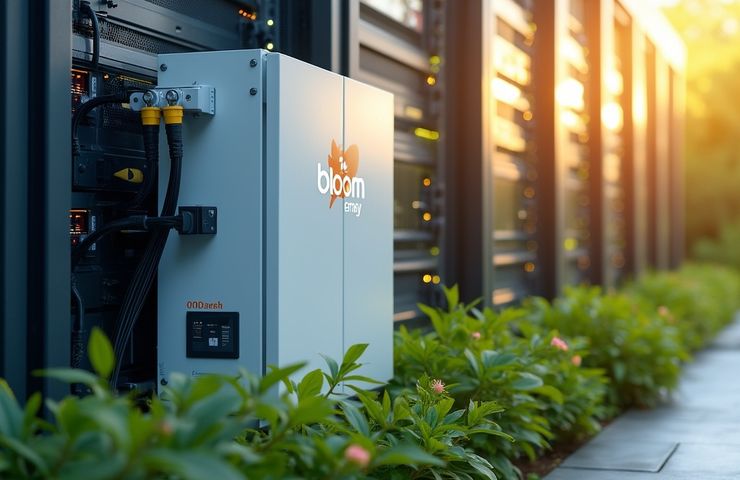
Fuel Cell Technology Gains Ground as Bloom Energy Gets Mizuho Upgrade
May 6, 2025Bloom Energy just caught a big break on Wall Street—and not just because of strong earnings. In May 2025, investment bank Mizuho bumped up the California-based company’s stock rating from Neutral to Outperform, thanks to surging demand for its solid-oxide fuel cell (SOFC) systems. But beyond the stock ticker, this upgrade says a lot about where energy is headed.
Fuel Cells Filling the Power Gap
Let’s face it—the power grid is stretched thin. Between booming data centers, electrified factories, and EV charging demands, the system’s under serious pressure. Add to that never-ending delays with upgrading grid infrastructure, and you’ve got industries looking for other options. That’s where Bloom’s fuel cell technology steps in.
Mizuho’s analysts see Bloom’s SOFC systems as a fast, clean alternative for companies that can’t sit around waiting a decade for a grid hookup. And this isn’t just hype—Bloom’s Energy Servers are already out in the field, making a real impact. Their modular setup means they’re up and running faster than old-school turbines or pollution-heavy diesel generators. Plus, they can be powered by natural gas, biogas, or increasingly, hydrogen—making them flexible and cleaner options for powering up energy-hungry facilities. In short, they don’t just support the grid; they help bypass its bottlenecks entirely.
Behind the Upgrade: Big Margins, Bigger Markets
Bloom’s growth numbers are hard to ignore. As of March 2025, it posted a 38.56% jump in year-over-year revenue. Sales from its 100MW-class products—worth over a billion dollars commercially—are picking up speed, especially in sectors that can’t afford downtime, like cloud platforms and advanced manufacturing. Meanwhile, the company’s been tightening up operations, growing its U.S. footprint, and planting flags in global markets.
There’s also growing momentum in the hydrogen fuel cell vehicle market, which could hit $15.9 billion by 2034. Even though most of the spotlight’s on mobility, that growth is fueling excitement around stationary fuel cell systems too. It’s all connected, and Bloom’s positioned itself right in that sweet spot.
Perfect Timing Meets the Right Tech
A few key trends are coming together, and Bloom’s in a great place to take advantage. CCGT (combined-cycle gas turbine) projects are getting more expensive and slower to finish. Grid connection wait times? In some areas, we’re talking a decade. And diesel backup generators are becoming dinosaurs thanks to stricter emissions rules.
That’s opening the door for companies like Bloom to step up—not just with a temporary fix, but with a long-term game plan. Their systems tick a lot of boxes when it comes to industrial decarbonization. They’re low in NOx and particulate emissions and fit into clean energy goals—especially when running on green hydrogen or biogas. For big energy users and utilities needing reliable power, this stuff is starting to look less like a niche and more like the future.
Riding the Hydrogen Momentum
Back in 2021, Bloom made a smart move into electrolyzer production, adding a powerful new layer to its clean energy lineup. While its core business is still fuel cells, expanding into hydrogen production shows they’re thinking big-picture—about energy security and independence.
Bloom’s electrolyzers use high-temperature electrolysis to split water into hydrogen and oxygen. That gives them an efficiency edge over traditional low-temp PEM units, especially when paired with heat recovery systems. It’s the kind of innovation that’s catching the eye of governments and companies around the world, especially in light of policy support like clean hydrogen tax credits and the U.S. Inflation Reduction Act.
What the Analysts Are Saying
Mizuho isn’t the only firm giving Bloom a nod. Analysts from Piper Sandler, Morgan Stanley, Truist Securities, and Jefferies are also taking a closer look. Sure, there are financial challenges—Bloom’s debt-to-equity ratio sits at 2.63—but there’s also a wave of optimism, driven by improving margins and solid customer traction. Most analysts hover around a 12-month price target of $24.77, with some seeing potential well above that mark.
The general feeling? Bloom still has hurdles to clear, but its potential as a key player in the shift toward cleaner, more reliable power is only growing stronger.
Clean Energy That Means Business
For investors, operators, and energy professionals watching the net-zero movement unfold, Bloom Energy is putting on a masterclass: harness proven tech, solve a pressing real-world problem—in this case, grid overload—and ride the momentum of smart energy policy. It’s not just about swapping diesel for fuel cells. It’s about reshaping how we think about resilient, on-demand power generation.
And with pressure mounting on both grids and policymakers, betting on flexible, clean options like fuel cell technology isn’t just a savvy move—it might be essential for what’s coming next.
About Bloom Energy
Founded in 2001 and based in California, Bloom Energy develops solid-oxide fuel cell systems that deliver decentralized, dependable power. While it started out working with natural gas, Bloom has since expanded to include biogas and hydrogen as energy inputs. Since 2021, it’s also been building solid-oxide electrolyzers aimed at producing low-carbon hydrogen—strengthening its position at the intersection of power and hydrogen production.



 With over 15 years of reporting hydrogen news, we are your premier source for the latest updates and insights in hydrogen and renewable energy.
With over 15 years of reporting hydrogen news, we are your premier source for the latest updates and insights in hydrogen and renewable energy.